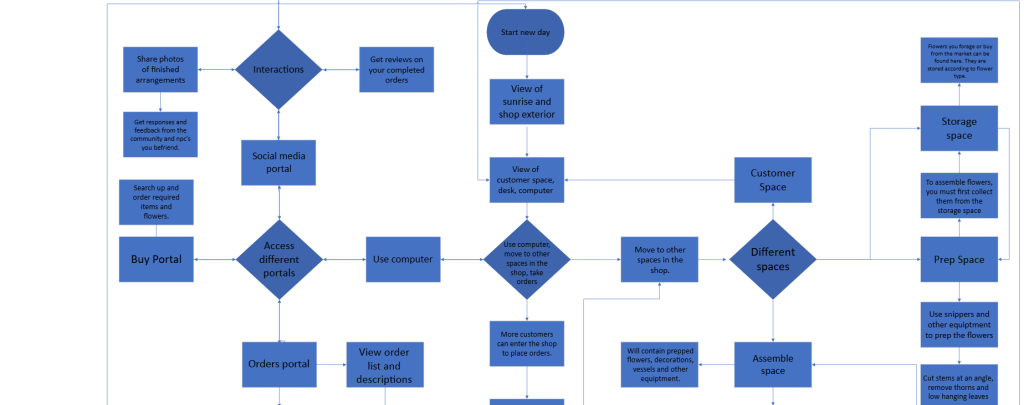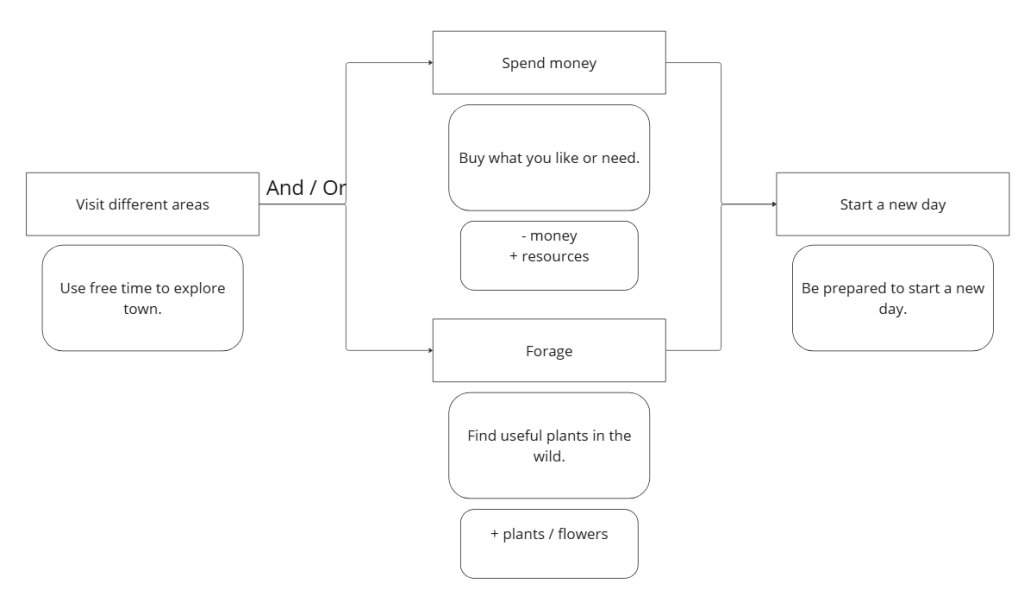Evergreen Grove is a Top-Down 2D pixel RPG with challenge and exploration gameplay. It is made up of two core gameplay loops and two overarching meta loops. Its core and meta loops are inspired by Papa’s games, Order Up!, Stardew Valley and BloomTale.
Evergreen Grove is a linear game which travels through in-game seasons, introducing storylines and challenges to the player. Each season (Autumn, Winter, Spring, Summer – the order they are experienced in-game) lasts for 4 weeks, a week being 7 game days. Once 16 weeks have passed in game, the player must make a choice – will they stay in the grove or move onto greener pastures? If they stay then the game ends with them heading into town to share the news. If they decide to leave, the game ends with them catching a train, and the floristry shop is shown boarded up and empty. There is no right or wrong decision, just a decision.
The game’s challenges and story lines allow the player to consider various issues, like the affects of capitalism on small businesses and towns, sustainability and environmental issues, and the loneliness of the modern pace of life.
Player Objectives
The players objective is to keep their business running smoothly. This is achieved by delivering orders on time, as requested and in good condition to get the best reviews from customers to bring them back, and catch the interest of more. To achieve this, players must stay focussed, attentive, and spend money wisely. The players side objectives are to engage in the main NPCs’ stories, however whether they choose to be helpful to them is up to the player. This can have negative repercussions, such as other NPCs moving from town or forming negative relationships with the player.
Win State: The game doesn’t have a real win state, But endings do have variations, depending on the choices made or the players success with running their business. If the player ends the game with less money and customers than ideal, at the end of the game if they choose to leave town, during the final cutscene the player character will make a comment about barely making any progress in the town. If they end the game with lots of money and customers, the player character will make a comment about how much the town has helped them grow.
If the player ends on good terms will all NPCs, and they decide to stay in Evergreen Grove, their friends will hold a party for them in town in the final cutscene. If they made friends with some NPCs but not others, only the friends will be seen at the party. If they made friends with none of the NPCs, or the NPCs dislike the player, the player will watch a party from outside, alone.
Fail states: There is no game over screen in Evergreen Grove, and the player doesn’t have to start again if they mess up. Gameplay will adjust automatically to the player, if they do well then they will get more customers with more specific orders, increasing their challenge. If they struggle with the floristry gameplay element but still enjoy the game and its other elements, this shouldn’t hold them back from their enjoyment. Gameplay is suited to all skill levels. Here are some examples of challenges players may face:
- The player runs out of money:
- If the player manages to run out of money, they will have to use resources they can find for free to make arrangements, they can do this for orders or sell them separately for a discounted price. This won’t give them much money, but hopefully enough to get them back on their feet.
- The player can also sell floristry resources to Aster by visiting her shop, interacting with her and pressing the Sell button. They then select what they want to sell and see the amount they will receive for each item.
- The player doesn’t gain new customers:
- There will still be 2 customers that will come to the shop regardless of the players success. Due to the easy difficulty of these customers orders, If the player gets stuck with them, the light gameplay should help them adjust and gradually bring in more customers when their skills improve.
- The player doesn’t deliver an order on time:
- They will lose that customer, unless they are the two easiest customers, who will return regardless. In any case, they wont receive payment for the undelivered order.
Gameplay Flowchart




This flowchart shows the timeline and options the player can explore in one in game day. Each day starts at 7am and ends at 12am. Each hour in the day lasts for 1 minute, a full day lasting 17 minutes. At 12am the end of day cutscene takes place, no matter where the player is. The in-game clock displays time in “ten minute” intervals (e.g. 7:00, 7:10…). The floristry gameplay loop lasts for 8 minutes, the town gameplay loop lasts for 9 minutes. This day cycle resets everyday and always stays the same, through every season.
Events: Sometimes during the town gameplay loop the player can attend town events that are advertised in shops. Talk to the shop owner where the event is advertised to access the event. Events usually take place in shops, the town hall or outside. Players can stay at the event until 12 am. Events provide an opportunity for the player to interact with NPCs, creating a fun atmosphere and a community environment. Players can interact with activities at events, and can buy things being sold there, often for discounted prices. Examples of events include:
- Autumn Harvest
- Spook fest
- Winter market
- Spring festival
- Summer Fair
- Clubs (craft club, bird spotting)
- Flea market
- Thrift market (Harpers storyline)
Core Gameplay Loops
Floristry gameplay:

Town gameplay:

Meta Gameplay Loops
Floristry gameplay:

Town gameplay:

Reply